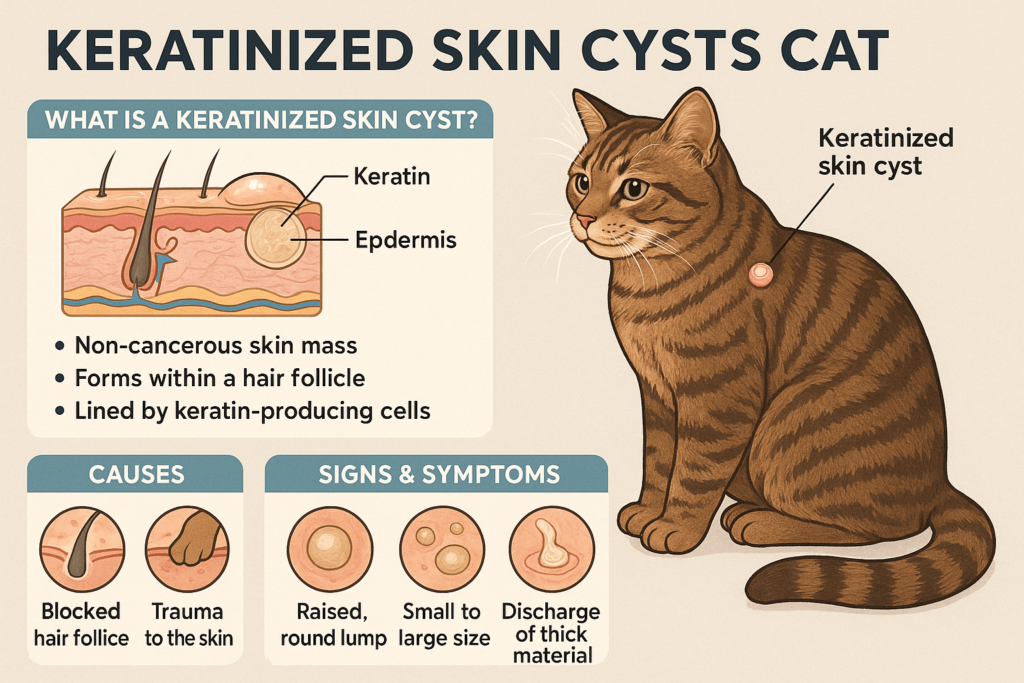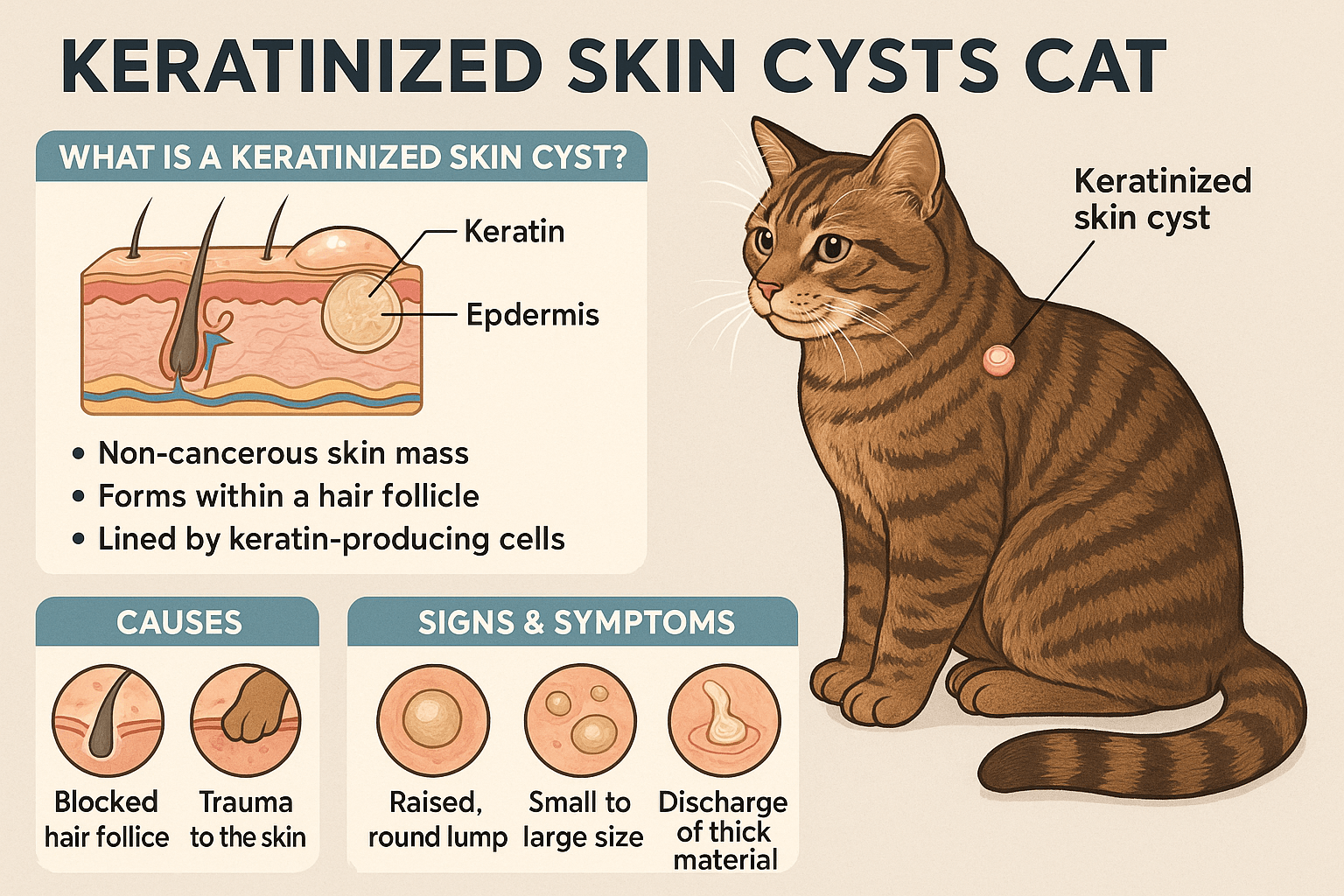Keratinized Skin Cysts in Cats: What You Need to Know
If you’ve noticed unusual lumps or bumps on your cat’s skin, you may be wondering what they are and whether they’re cause for concern. One common condition that can affect felines is keratinized skin cysts—small, benign growths caused by the buildup of keratin beneath the skin. While these cysts are typically harmless, understanding their causes, symptoms, and treatment options is essential for ensuring your cat’s comfort and health. In this guide, we’ll explore everything you need to know about keratinized skin cysts in cats, from identifying them early to managing their care effectively.
Expert Insight: Understanding Bumps and Lumps in Cats
“Others bumps or lumps can be painful or irritating, while others don’t seem to bother cats at all. Some grow on the skin, while others grow deep beneath the skin.”
What Are Keratinized Skin Cysts?
Keratinized skin cysts in cats occur when excess keratin—a protein found in hair, nails, and skin—accumulates under the skin, forming a small, round lump. These cysts are usually harmless but can sometimes cause discomfort if they grow large or become irritated. Here’s what you should know about their characteristics and causes.
Appearance:
Keratinized cysts often appear as firm, smooth, dome-shaped bumps just beneath the skin’s surface. They may vary in size from a few millimeters to a couple of centimeters.Location:
These cysts commonly develop on areas of the body where friction occurs, such as the neck, shoulders, or back.Causes:
The exact cause of keratinized cysts isn’t always clear, but factors like trauma, blocked hair follicles, or genetic predispositions may contribute.Symptoms:
Most keratinized cysts don’t cause pain unless they rupture or become infected, which might lead to redness, swelling, or discharge.Non-Cancerous Nature:
Unlike tumors, keratinized cysts are benign and do not spread to other parts of the body, making them less concerning than malignant growths.
Understanding these basics helps pet owners identify keratinized cysts early and seek appropriate care when needed.

Signs Your Cat May Have a Keratinized Skin Cyst
Detecting a keratinized skin cyst early allows you to monitor its development and take action if complications arise. Keep an eye out for these signs that may indicate your cat has one.
Visible Lumps:
Check your cat’s skin regularly for any unusual bumps, especially in high-friction areas like the neck or back.Hair Loss Around the Area:
Hair thinning or bald patches near the cyst could indicate irritation or self-trauma caused by your cat licking or scratching at it.Behavioral Changes:
If your cat seems unusually sensitive or avoids being touched in certain areas, it could signal discomfort related to a cyst.Redness or Swelling:
Irritation or infection around the cyst may cause the surrounding skin to appear inflamed or swollen.Discharge or Odor:
A ruptured cyst might release a thick, yellowish substance and emit a foul smell due to bacterial contamination.
Recognizing these signs enables you to address potential issues promptly and ensure your cat stays comfortable.
Check this guide 👉Understanding Cat Skin Conditions: Best 7 Health Tips!
Check this guide 👉Dry Skin on Cats: Best 7 Expert Tips!
Check this guide 👉What to Do About a Hole in Your Cats Skin: Best 7 Tips!
Symptoms of Keratinized Cysts | When to Contact a Vet |
|---|---|
Firm, round bumps under the skin | If the cyst grows rapidly or changes shape |
Hair loss around the affected area | If there’s redness, swelling, or discharge |
Sensitivity or pain during touch | If your cat shows signs of distress or lethargy |
Foul odor from the cyst | If the cyst becomes infected or ruptures |
Behavioral changes (e.g., licking) | If multiple cysts appear suddenly |
Treatment Options for Keratinized Skin Cysts
While many keratinized skin cysts resolve on their own, some cases require intervention to prevent complications. Depending on the severity, several treatment approaches are available.
Monitoring Without Intervention:
For small, asymptomatic cysts, veterinarians may recommend simply keeping an eye on them to ensure they don’t worsen over time.Warm Compresses:
Applying warm compresses to the area can reduce inflammation and encourage natural drainage if the cyst is close to rupturing.Surgical Removal:
Persistent or problematic cysts may need surgical excision to prevent recurrence or further irritation.Antibiotics for Infections:
If the cyst becomes infected, oral or topical antibiotics may be prescribed to clear up the infection and promote healing.Preventive Measures:
Reducing friction or irritation in susceptible areas can help minimize the risk of new cyst formation.
By working closely with your vet, you can choose the best course of action tailored to your cat’s needs.
How to Prevent Keratinized Skin Cysts in Cats
While not all keratinized cysts can be prevented, taking proactive steps can reduce the likelihood of their development and improve your cat’s overall skin health.
Regular Grooming:
Brushing your cat’s coat regularly removes loose hair and debris, reducing the chance of blocked follicles that could lead to cysts.Avoiding Excessive Friction:
Minimize activities or gear (like collars) that cause constant rubbing against the skin, particularly in sensitive areas.Maintaining a Healthy Diet:
A balanced diet rich in omega-3 fatty acids supports healthy skin and reduces the risk of dermatological issues.Routine Skin Checks:
Inspect your cat’s skin weekly for any abnormalities, catching potential problems before they escalate.Prompt Veterinary Care:
Address minor skin irritations quickly to prevent them from developing into more serious conditions like cysts.
These preventive measures go a long way in safeguarding your cat’s skin and overall well-being.
Common Misconceptions About Keratinized Skin Cysts
There are several misconceptions about keratinized skin cysts that can lead to confusion among cat owners. Clearing up these myths helps foster a better understanding of the condition.
Myth: All Skin Lumps Are Cancerous:
Many assume any lump is cancerous, but keratinized cysts are non-cancerous and rarely pose serious risks.Myth: Cysts Always Require Surgery:
Not all cysts need surgical removal; many can be monitored without intervention.Myth: Cysts Are Contagious:
Keratinized cysts cannot be transmitted between animals or humans, as they result from individual skin conditions.Myth: Home Remedies Can Cure Cysts:
While some home care methods help, attempting to “cure” cysts without veterinary advice can worsen the situation.Myth: Only Older Cats Develop Cysts:
While older cats are more prone to skin issues, younger cats can also develop keratinized cysts.
Dispelling these myths empowers cat owners to make informed decisions about their pet’s health.
How to Comfort Your Cat During Treatment
If your cat requires treatment for a keratinized skin cyst, providing comfort and reassurance is crucial. These tips can help ease their stress and speed up recovery.
Create a Calm Environment:
Reduce noise and activity levels in your home to create a soothing atmosphere for your cat.Offer Soft Bedding:
Provide plush bedding to cushion the affected area and prevent further irritation.Use Distraction Techniques:
Engage your cat with toys or gentle play to distract them from focusing on the cyst.Administer Medication Properly:
Follow your vet’s instructions carefully when giving medications, using treats or praise to make the process easier.Monitor Progress Regularly:
Keep track of the cyst’s appearance and report any changes to your vet promptly.
Supporting your cat emotionally and physically ensures a smoother treatment experience.
When to Seek Emergency Veterinary Care
While most keratinized cysts are manageable, certain scenarios warrant immediate veterinary attention. Being aware of these red flags ensures timely intervention.
Rapid Growth of the Cyst:
A cyst that enlarges significantly within days should be evaluated urgently to rule out malignancy.Severe Pain or Aggression:
If your cat reacts aggressively or appears to be in extreme pain, seek emergency care immediately.Excessive Bleeding:
Heavy or prolonged bleeding from a ruptured cyst requires urgent medical attention.Signs of Systemic Illness:
Symptoms like lethargy, loss of appetite, or fever alongside a cyst could indicate an underlying issue.Difficulty Breathing:
Swelling near the throat or chest area affecting breathing demands immediate veterinary assistance.
Knowing these warning signs ensures you act swiftly to protect your cat’s health.
Frequently Asked Questions About Keratinized Skin Cysts in Cats
Are keratinized cysts dangerous for my cat?
No, they are usually benign and harmless unless they become infected or cause discomfort.
Can I pop a keratinized cyst myself?
It’s best to avoid doing so, as improper handling can introduce bacteria and lead to infection.
Will the cyst go away on its own?
Some cysts may resolve naturally, but persistent ones may require veterinary evaluation.
Is surgery always necessary?
Surgery is only recommended for problematic cysts; most cases can be managed conservatively.
How can I tell if the cyst is infected?
Look for signs like redness, swelling, discharge, or a foul odor, and consult your vet if you notice any of these symptoms.
Caring for Your Cat’s Skin Health
Keratinized skin cysts in cats, while generally harmless, highlight the importance of attentive pet care. By staying vigilant, recognizing early signs, and seeking professional guidance when needed, you can ensure your feline friend remains happy and healthy. Remember, even seemingly minor skin issues deserve attention, as they can impact your cat’s quality of life. With proper monitoring and care, you can address keratinized cysts effectively and enjoy peace of mind knowing your beloved companion is thriving.
Can a Cat Die from a Cold? Best 7 Expert Tips! Learn how to identify, treat, and prevent feline colds while understanding when to seek veterinary care for your cat’s health.
Cat Screaming for Food: Best 7 Expert Tips! Discover effective strategies to manage your cat's food-related vocalizations and create a peaceful feeding routine.
Aspiration Pneumonia in Cats: Best 7 Expert Tips! Discover causes, symptoms, and treatment advice to protect your cat’s respiratory health and ensure a speedy recovery.
Hip Dysplasia in Cats: Best 7 Expert Tips! Discover expert advice on managing hip dysplasia in cats, from symptoms and prevention to treatment options for a happier, healthier feline life.





